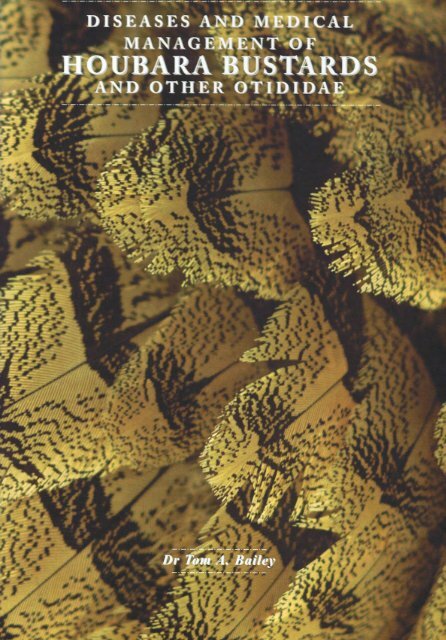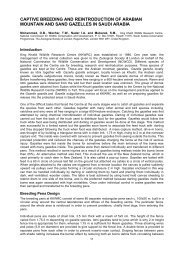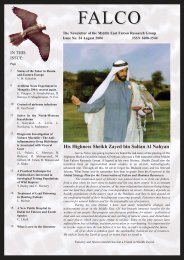DISEASES AND MEDICAL MANAGEMENT OF HOUBARA
DISEASES AND MEDICAL MANAGEMENT OF HOUBARA
DISEASES AND MEDICAL MANAGEMENT OF HOUBARA
Create successful ePaper yourself
Turn your PDF publications into a flip-book with our unique Google optimized e-Paper software.
<strong>DISEASES</strong> <strong>AND</strong> <strong>MEDICAL</strong> <strong>MANAGEMENT</strong> <strong>OF</strong> <strong>HOUBARA</strong> BUSTARDS <strong>AND</strong> OTHER<br />
OTIDIDAE<br />
Tom Bailey<br />
ISBN 978-9948-03-562-6<br />
Published 2008, Emirates Printing Press LLC, Dubai<br />
494 pages<br />
The most comprehensive book published on the management and veterinary care of<br />
bustards has finally been published! This book will be an essential reference to those<br />
working with captive or wild bustards, and it also contains a wealth of information that will<br />
make it useful to anyone working with many other species of birds in the Middle East. The<br />
book has been supported by the National Avian Research Centre, Abu Dhabi, one of the<br />
foremost organisations conducting research on and breeding the houbara bustard. An<br />
international team of authors have contributed chapters to the book. The Table of Contents<br />
is listed below:<br />
Table of Contents<br />
Chapter Section 1 – Conservation, Biomedical Programmes and Captive Management of Bustards<br />
1. Introduction<br />
Tom Bailey<br />
2. Veterinary Considerations of Bustard Captive Breeding, Rehabilitation and Restoration<br />
Programmes<br />
Tom Bailey<br />
3. Important Aspects of Managing Bustards in Captivity<br />
Tom Bailey and Olivier Combreau<br />
Section 2 – Clinical Investigations and Laboratory Diagnostics<br />
4. Clinical Workup of Bustards<br />
Tom Bailey, Antonio Di Somma and Christudas Silvanose<br />
5. Biochemistry of Bustards<br />
Tom Bailey<br />
6. Haematology of Bustards<br />
Jaime Samour and Judith Howlett<br />
7. Bustard Diagnostic Cytology<br />
Christudas Silvanose and Tom Bailey<br />
8. Radiology of Bustards<br />
Jesus Naldo<br />
9. Endoscopy of Bustards<br />
Jaime Samour<br />
10. Surgery and Anaesthesia<br />
Tom Bailey<br />
11. Post-mortem Examination and Biomedical Reference Collections<br />
Philip Nicholls, Tom Bailey and François Lampen<br />
Section 3 - Therapeutics and Preventive Medicine
12. An Introduction to the Medication of Bustards<br />
Tom Bailey<br />
13 Supportive Care and Therapy of Hospitalised Bustards<br />
Tom Bailey<br />
14. Preventive Medicine Programmes for Bustard Collections<br />
Tom Bailey<br />
Section 4 – The Diseases of Bustards<br />
15. Introduction to Transmissible Diseases<br />
Tom Bailey<br />
16. Viral Diseases<br />
Tom Bailey, Ulrich Wernery and Joerg Kinne<br />
17 Bacterial Diseases<br />
Tom Bailey, Ulrich Wernery and Joerg Kinne<br />
18 Fungal Diseases<br />
Tom Bailey and Christudas Silvanose<br />
19. Parasitic Diseases<br />
Tom Bailey and Rolf Schuster<br />
20. Non-Infectious and Miscellaneous Diseases<br />
Tom Bailey, Ulrich Wernery and Joerg Kinne<br />
21 Clinical Signs and Differential Diagnosis of the Main Observed Disorders of Bustards<br />
Tom Bailey<br />
22. Neonatal Diseases<br />
Tom Bailey, Peter McKinney and Corinne Stiévenart<br />
Section 5 – The Health of Free-living and Rehabilitated Houbara Bustards<br />
23. The Health of Free-living Houbara Bustards<br />
Tom Bailey, Olivier Combreau and Mark Lawrence<br />
24. Veterinary Aspects of the Bustard Trade and Rehabilitation Programmes<br />
Francois Lampen, Tom Bailey, Arshad Toosy and Olivier Combreau<br />
Section 6 – Acknowledgments, Appendices, References and Index<br />
25. Acknowledgments<br />
26. Appendices<br />
27. References<br />
28. Index<br />
Section 7 – Further Documents<br />
CD1. Medical Record Keeping For Bustard Projects<br />
Tom Bailey<br />
CD2. The Anatomy of the Alimentary Tract in Bustards<br />
Tom Bailey<br />
CD3. Haematology Techniques for Bustards<br />
Jaime Samour and Judith Howlett<br />
Ordering a Copy<br />
Copies of Diseases and Medical Management of Houbara Bustards and Other Otididae are<br />
available from Tom Bailey. Contact: tom.bailey@dfh.ae
BOOK REVIEW - <strong>DISEASES</strong> <strong>AND</strong> <strong>MEDICAL</strong> <strong>MANAGEMENT</strong> <strong>OF</strong> <strong>HOUBARA</strong> BUSTARDS<br />
<strong>AND</strong> OTHER OTIDIDAE<br />
Reviewed by John Chitty BVetMed CertZooMed MRCVS<br />
It is de rigeur when reviewing textbooks to criticise. After all, in the majority of reviews, it is the<br />
reviewers duty to tell prospective readers why they should buy that particular book over its rivals. This<br />
is not the case for this book. It is unique. While bustards are included in Jaime Samour’s excellent<br />
“Avian Medicine” they are largely ignored in other texts as the majority of veterinary practitioners in<br />
the US and Europe (the major marketing areas for publishers!) will probably never work with them.<br />
Therefore this book has no competition and even if very poor the reviewer would have to recommend<br />
it! Fortunately this reviewer faces no such dilemma! The book is excellent and contains a vast<br />
amount of knowledge on these species.<br />
There were, I thought, grounds for complaint. My main area of interest is the Great Bustard not the<br />
Houbara. As I read through the pages I had a growing feeling that this was not a book about bustards<br />
but about the Houbara. Yes, I did then read the title! The title beautifully describes the contents of the<br />
book yet, even though the vast majority of the book is devoted to the Houbara, there is an awful lot for<br />
those working with other bustard species.<br />
However, it is still a little sad that the chapters on captive management and breeding couldn’t contain<br />
more on the successful Kori breeding programme in the United States or the Little Bustard in France.<br />
Minor complaint – the book is large enough already and there are plenty of references to much of this<br />
information.<br />
The veterinary sections are, again, complete. They contain much in-depth knowledge on the medical<br />
problems of these species as well as diagnostic techniques anaesthesia and surgery. This information<br />
ranges from the basic through to very advanced. I anticipated a book that would assist an experienced<br />
avian veterinarian about to work with novel species. Instead this is a book that will not only do this but<br />
will also be eminently suitable for those with little general avian experience and who do not have easy<br />
access to other sources of information – ie it will be perfect for use in the field (although a large<br />
rucksack will be needed!).<br />
The picture quality is very good and there are plenty of them. I am sure that if I made a huge effort I<br />
could unearth many minor criticisms or some facts with which I disagree (this is actually unlikely – the<br />
authors have included so much of what is published on bustards that few arguments are not well<br />
covered!), however, I do not see the need – it is clearly a labour of love and to nitpick a text that<br />
represents huge amounts of work by all authors seems simply unjust.<br />
The book is excellent. It must be indispensable to all working with Houbara – veterinarians, of course,<br />
but also biologists and all involved in the captive management, conservation, and field studies of this<br />
species. It is also essential for veterinarians, biologists, researchers, and zoological collections<br />
working with other bustard species.<br />
It is hard to recommend it for those not directly working with bustards, although it is a well-written and<br />
interesting book and, to be honest, it is a book that covers the basics of clinical sampling,<br />
anaesthesia, surgery and therapeutic techniques very well. I would, therefore, be very happy to advise<br />
any veterinary student or inexperienced avian veterinarian to read it as well even if their primary focus<br />
was with other avian species.<br />
Congratulations to Tom and all the authors – this is an impressive work and I know that my copy will<br />
be very well-thumbed!




